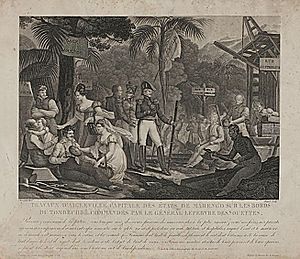Vine and Olive Colony facts for kids
The Vine and Olive Colony was a special settlement started by a group of French people. These people were supporters of Napoleon Bonaparte, a famous French leader. After Napoleon lost power, they were worried for their safety in France. So, they decided to move to the wild lands of Alabama in the United States. Their big idea was to grow wine grapes and olive trees there. The area they settled later became parts of Marengo and Hale counties.
Contents
Starting the Vine and Olive Colony
The idea for the Vine and Olive Colony came from a group called the French Emigrant Association. This group was made up of important French officials and followers of Napoleon. They were afraid for their lives after Louis XVIII became king of France again.
Finding a New Home
In the fall of 1816, this group, led by former General Charles Lallemand, decided to ask the U.S. government for land. They wanted four large areas where they could settle. They explored the western parts of the Southern United States to find the best spot. They chose a place where the Black Warrior and Tombigbee Rivers meet. Other pioneers had suggested this location.
Getting Land from Congress
The United States Congress agreed to let them settle. On March 3, 1817, Congress passed a law giving them four connected areas of land. This was about 92,160 acres (373 square kilometers). They had to pay $2 per acre. There was one important rule: they had to grow grapes and olives. This rule was put in place because other French settlements around the world were thought to be secret military plans to bring Napoleon back to power.
The Journey to Alabama
After crossing the Atlantic Ocean, the settlers first arrived in Philadelphia, Pennsylvania. The largest group hired a schooner ship called the McDonough. This ship took them from Philadelphia to Mobile, Alabama. They reached Mobile by May 26, 1817. From there, they traveled up the rivers. On their way, they stopped at Fort Stoddert and Fort Montgomery. They met General Edmund P. Gaines there. The group finally arrived at their chosen spot, called Ecor Blanc, on the Tombigbee River by July 14, 1817. Ecor Blanc means "White Bluff" or "White Cliff" in French.
Important Leaders and New Towns
One of the most important and wealthy settlers was Count Charles Lefebvre Desnouettes. He had been a high-ranking cavalry officer under Napoleon. He became the leader of the colony. Other important settlers included Baron Henri-Dominique Lallemand (Charles's brother), Count Bertrand Clausel, and Joseph Lakanal.
The colonists, about 200 people, soon built a town called Demopolis. This name means "City of the People." They built it on top of White Bluff. However, after a land survey in August 1818, they learned their land grants actually started almost a mile east of their new town. So, they left Demopolis. They then built two other towns: Aigleville and Arcola. Aigleville was named after Napoleon's eagle flag. Arcola was named after the Battle of the Bridge of Arcole, a place where Napoleon won a big battle in 1796. Arcola grew to be the largest town in the colony.
Why the Colony Declined
After settling in, the colonists soon found out that their land was not good for growing grapes or olives. This was the main rule for their land grants from Congress. The colony sent a representative, Charles Villar, to Washington to explain their problem. Congress helped them with a new law on April 26, 1822. This law allowed the settlers to keep their land even if growing grapes and olives didn't work out.
However, the colony faced many other problems. They did not have enough workers. American squatters kept moving onto their land. They also had floods and droughts in their first few years. All these issues led to the colony eventually failing. After 1825, most of the settlers left. Many went back to France, or moved to Mobile or New Orleans, Louisiana. But a few did stay on their land permanently.
Lasting Legacy
Demopolis is still a town today. However, Aigleville and Arcola were mostly gone by the time of the American Civil War. The settlers' efforts are remembered in the names of the county and its main town. The county is called Marengo, named after Napoleon's victory at the Battle of Marengo in 1800. The county seat was first called the Town of Marengo. But in 1823, its name was changed to Linden. Linden is a shorter version of Hohenlinden, another place where Napoleon won a battle in 1800.


